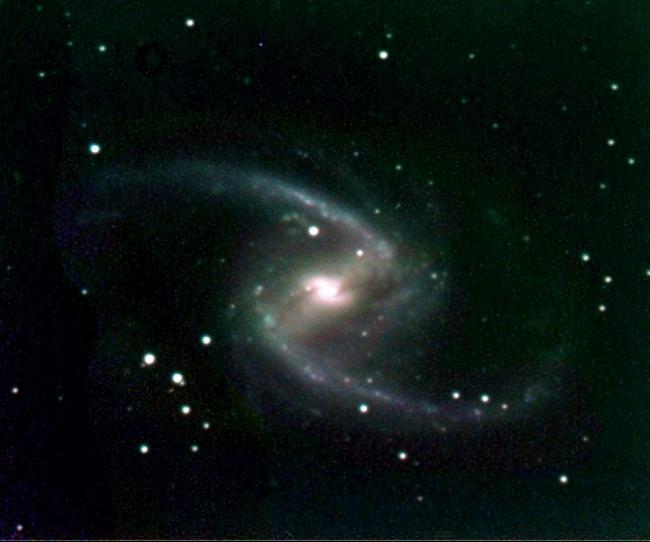
An optical photo of the galaxy NGC 1365. This galaxy has a massive black hole at its center, and SAO astronomers have used the Chandra X-ray Observatory to measure the size of the hot, X-ray emitting source around this black hole, which is only about twice the size of our solar system.
Astronomers have come to realize that black holes are fairly common in the universe. Massive black holes -- ones that contain millions or even billions of solar masses of material -- are thought to reside at the centers (nuclei) of most galaxies, including our own Milky Way. These stupendous objects help to determine the behavior of galaxies through their powerful gravitational force and so are of fundamental importance, yet astronomers do not understand their nature, how they develop, or how they affect the subsequent evolution of a galaxy and its stars.
Active galactic nuclei (AGN) have massive black holes which are vigorously accreting material in a process that typically results in the ejection of jets of particles, and the stimulation of the environment to radiate brightly at many wavelengths, most notably in the X-ray and the infrared. SAO astronomers Guido Risaliti, Martin Elvis, Pepi Fabbiano, Alessandro Baldi, and Andreas Zezas, together with a colleague, report using the Chandra X-ray Observatory to study one such AGN that was known to vary in X-ray brightness on a timescale of weeks. Because such rapid variations are difficult to explain via changes in the X-ray emitting gas, the scientists argue instead that the variability is produced by occultation of the AGN by intervening clouds of gas and dust that move into or out of our line-of-sight to the X-ray emitting region. Writing in the Astrophysical Journal Letters, the team reports that careful monitoring and analysis of the variable X-ray light shows that the emission originates in a region whose size is remarkably small
-- corresponding roughly to less than the diameter of our solar system
proper, i.e., twice the distance of Pluto from our Sun. Furthermore,
they calculate from their measurements that the obscuring cloud itself lies only about a hundred times farther away from the X-ray emitting region, possibly as part of a circumnuclear torus of material. If so, this torus is much more compact than had been previously imagined, and may also play a role in feeding the accretion process. The new results provide some of the first direct measurements of the environments of these exotic, supermassive black holes.
CfA In The News
CfA astronomer John P. Huchra has been elected the next president of
the American Astronomical Society, with a term ending in June 2010.
The Hinode (Japanese for "sunrise") satellite was launched last
September to study the sun's magnetic field and how its explosive energy
propagates through the different layers of the solar atmosphere. One of
the three instruments on board Hinode is the X-Ray Telescope, developed
and built by the SAO and the Japan Aerospace Exploration Agency. Last
month the first preliminary results of Hinode were released: "We've
seen many new and unexpected things," says Leon Golub, senior
astrophysicist at the CfA. "Everything we thought we knew about X-ray
images of the sun is out of date."
Education and Public Outreach
At the recent National Science Teachers Association conference in St.
Louis, CfA-affiliated researchers and science educators presented at 13
of the professional development sessions; these sessions reached over
400 educators from across the country. Topics included: (1) informing
teachers of the latest astrophysics research from the SAO; (2)
disseminating results from SAO education research projects ("FICSS:
What Factors from High School Really Help in College Science" and
"MOSART: Assessing What Teachers and Students Really Know!"); (3)
presenting CfA-developed video-based professional development resources
("The Habitable Planet: A Systems Approach to Environmental Science" and
"From Tropical Rainforests to Distant Galaxies"); and, (4) engaging
teachers in "authentic inquiry" using Chandra data and CfA's
MicroObservatory telescopes ("Decoding Starlight: From Pixels to Images"
and "How Far Are the Stars? Investigations in Astronomy Using the
MicroObservatory Online Telescopes").